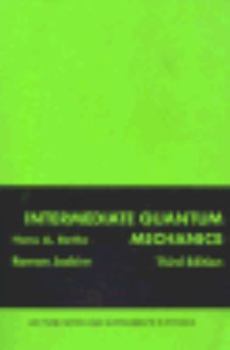Intermediate Quantum Mechanics
Select Format
Select Condition 
Book Overview
"Graduate students in both theoretical and experimental physics will find this third edition of Intermediate Quantum Mechanics, refined and updated in 1986, indispensable. The first part of the book... This description may be from another edition of this product.
Format:Paperback
Language:English
ISBN:0805307575
ISBN13:9780805307573
Release Date:January 1986
Publisher:Benjamin-Cummings Publishing Company
Length:396 Pages
Weight:1.35 lbs.
Dimensions:0.7" x 6.2" x 9.2"
Related Subjects
Physics Quantum Theory Science Science & Math Science & Scientists Science & Technology TextbooksCustomer Reviews
3 ratings
very good
Published by Thriftbooks.com User , 20 years ago
This is a very useful book, but only for someone with a solid grasp of QM at the undergrad level. The only problem is the terrible type in which the equations are set. Why Addison-Wesley released a new edition without fixing this is beyond me.(profit, perhaps? No, never on a scholarly textbook.)
A good overview
Published by Thriftbooks.com User , 21 years ago
That quantum mechanics must be understood by anyone working in any area of technology is now well accepted. Indeed, semiconductor device physics, proteomics, and computational chemistry are just three of the more modern areas where a through knowledge of quantum mechanics is needed in order to make any kind of significant progress. This book, written by two of the major players in the development of quantum mechanics in the 20th century, is an excellent overview of how to do practical computations in quantum mechanics. The book is addressed primarily to the aspiring atomic physicist and spectroscopist, but it could serve well anyone interested in the applications of quantum mechanics, such as those in the aforementioned fields. Due to space limitations, I will only review the first 8 chapters of the book. Chapter 1 is a brief overview of elementary quantum mechanics, and the authors set down the notation and units to be followed in the book. They state the main goal of the book, which is to solve the Schrodinger equation for an atom with nuclear charge Ze. This problem for one-electron is straightforwardly solved, but for more than one electron approximation techniques must be used, a few of which they mention. Since spin will have to be dealt with throughout the book, the authors include a description of spin 1/2 particles. In chapter 2 the authors discuss the use of symmetry principles in quantum many-particle systems, pointing out the origin of exchange degeneracy and the Pauli exclusion principle. The authors also give an interesting discussion of the experimental determination of symmetry, particularly their argument for the absence of hidden variables. In chapter 3 the authors give an overview of the quantum mechanics of two-electron atoms, pointing out that the calculations give six-figure agreement between theory and experiment. Perturbation and variational methods are used to solve the Schrodinger equation for this system, and show the origin of the triplet and singlet levels for the helium atom. In chapter 4, the authors introduce another approximation technique, the self-consistent field or "Hartree-Fock" method, in order to calculate the excited states for the two-electron atom more efficiently. This approach involves using a variational trial function, called the determinantal wave function, as an ansatz, which because of orthogonality and parity considerations, results in a set of equations, called the Hartree-Fock equations, for the single electron orbitals. The "exchange term" in these equations is discussed in detail, involving a notion of a "nonlocal" potential. The physical significance of the eigenvalue in these equations is also discussed, and related to the famous Koopman theorem. It is proven also that atoms with closed shells leads to a spherically symmetric theory. The periodic table is shown to be a consequence of the Pauli principle and the Hartree-Fock calculation. An improvement to Hartree-Fock, the Thomas-Fe
Learn to apply your quantum mechanics
Published by Thriftbooks.com User , 25 years ago
The "Intermediate" of the title means that you are supposed to have learned your basic QM in a book such as Griffiths' "Introduction to Quantum Mechanics" . Bethe's text then leads you to those parts of QM most successful in applications, especially in atomic structure. The treatment of perturbation theory is very clean, simple and effective. The semi-classical theory of radiation is excellently described and then, in perhaps the best part of the book, is used to review Einstein's derivation of Planck's equilibrium distribution of radiation, explaining the need for spontaneous emmission and motivating the treatment of quantum electrodynamics, outlined at the end of the text. This is a great book. What else could one expect from Hans Bethe, the man who discovered how the Sun produces its energy?





